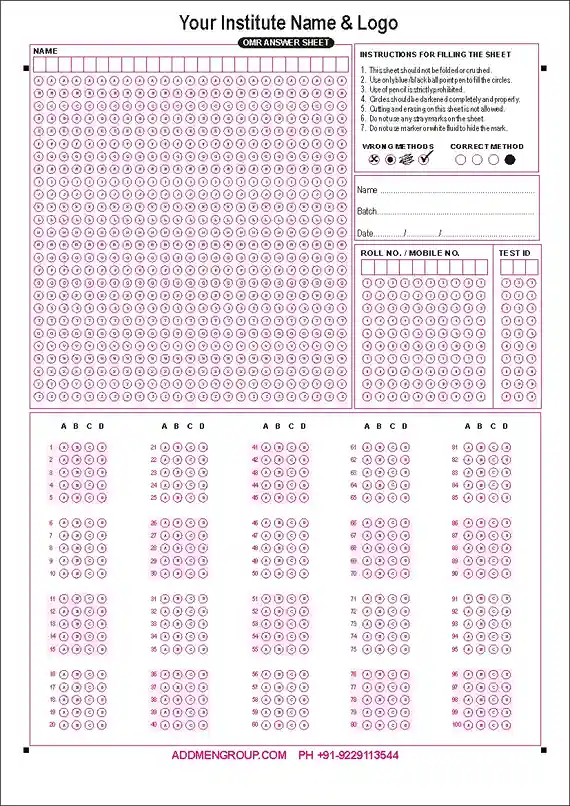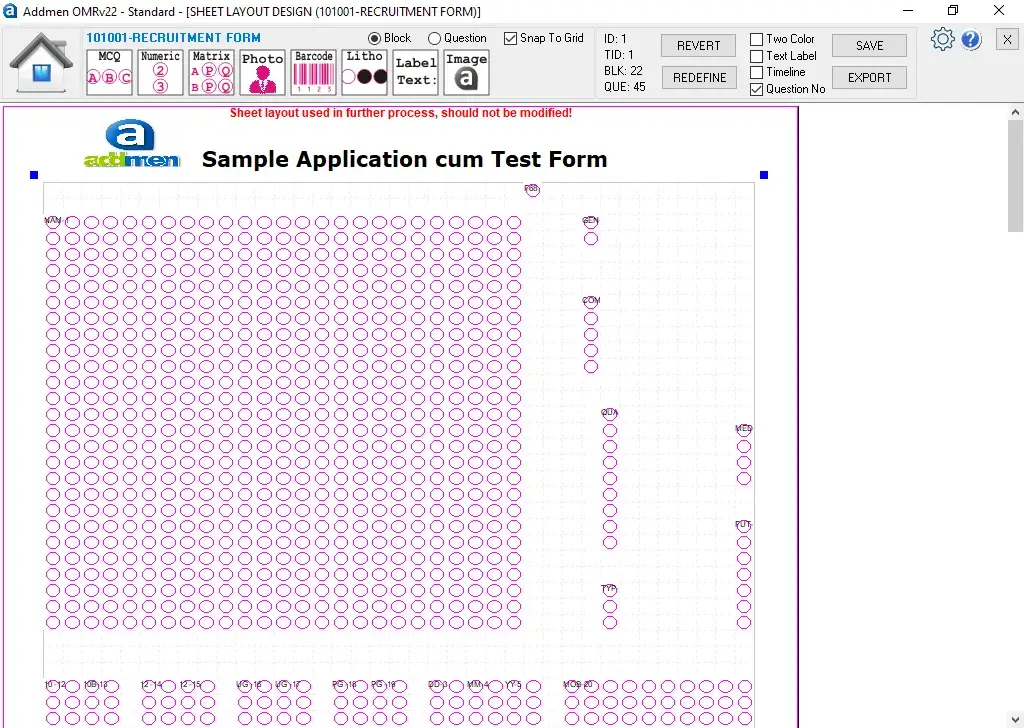The Addmen OMR Sheet Reading Software includes a built-in OMR Sheet Designing Module, allowing users to create professional, scannable OMR sheets without needing any additional software.
The OMR Sheet Designer is an add-on module available with Addmen’s OMR Software suite.
It allows users to design answer sheets, admission forms, feedback sheets, or custom data-collection sheets using an intuitive drag-and-drop interface.
Each sheet design is technically designed to ensure perfect alignment with the OMR reading software, guaranteeing 100% accuracy in scanning and evaluation.
Select and place question matrices, roll number bubbles, or barcode boxes anywhere on the page. The interface lets you drag, resize, and align elements easily.
After defining the technical OMR zones, export the layout to your preferred editing software (such as CorelDRAW and Inkspace) to add institutional logos, titles, or additional text.
Once finalized, sheets can be printed using any standard laser or inkjet printer on regular A4 or legal-size paper — no need for costly special sheets.
Every OMR sheet created in Addmen’s software is automatically optimized for accurate reading, eliminating manual calibration errors.
The Addmen OMR Sheet Designer Module allows you to create any type of OMR sheet layout with complete flexibility. Whether you need answer sheets for objective tests, admission forms for data collection, or custom sheets for special purposes — everything can be designed using the inbuilt OMR sheet designer.
Purpose: Used for evaluating multiple-choice or objective-type examinations.
These sheets are also known as OMR Test Sheets, MCQ Test Sheets, or Test Answer Sheets.
Features:
Question bubbles arranged in multiple columns or sections.
Roll number and test code fields for student identification.
Support for multiple sets of question papers (A, B, C, etc.).
Option to include barcodes, logos, or instructions.
Purpose: To collect structured information in a digital format using OMR technology.
OMR forms are ideal for surveys, registrations, and administrative documentation.
Common Types:
OMR Application Forms – for admission, recruitment, or registration processes.
OMR Admission Forms – to capture student or candidate details quickly and accurately.
OMR Feedback Forms – for collecting feedback in educational, event, or service environments.
OMR Questionnaires & Surveys – for research, evaluation, and feedback analysis.
Advantages:
Automated data capture reduces manual entry errors.
Uniform layout ensures easy reading and processing.
Compatible with any standard scanner and printing setup.
Apart from standard answer sheets and forms, Addmen’s OMR Sheet Designer can create special-purpose OMR sheets tailored to institutional needs.
Examples:
OMR Attendance Sheets: For tracking participant or student presence.
OMR Mark Sheets / Award Sheets: For recording and processing marks in examinations.
OMR Ballot Sheets: For elections, surveys, or polls requiring anonymous selections.
OMR Quality Cards: For rating, evaluation, or grading activities in workshops and training programs.
Each of these layouts can be fully customized with branding, variable data fields, and unique bubble patterns as per your requirements.


Addmen OMR Sheet Design Software enables you to design any type of OMR sheet layout with complete freedom and flexibility.
There is no limitation on the number of OMR sheet designs you can create. Whether you need compact slips for quick data capture or large-format sheets for full-length examinations, Addmen software supports every requirement.
OMR sheets can be designed and printed in any size — from small stamp-sized slips to A3 sheets, ensuring full adaptability for academic, corporate, or survey purposes.
The software supports multiple types of bubble and marking blocks, allowing you to create fully customized layouts for exams, forms, or data-collection applications.
ABCD-Type Blocks: For multiple-choice questions and answer marking.
Matrix-Type Blocks: For tabular data entry or multi-dimensional responses.
Integer-Type Blocks: For numerical data like roll numbers, dates, or scores.
Barcode Blocks: For automatic identification of students, applicants, or forms.
ICR/OCR Blocks: For recognizing handwritten or printed text, ensuring flexibility in hybrid OMR-OCR-ICR data capture.
Image Blocks: For capturing signatures, photos, or image-based responses.
These elements can be freely combined in any arrangement to design your desired sheet layout. The designer provides full control over alignment, spacing, and calibration for accurate OMR reading.
The Addmen OMR Sheet Designer allows you to create duplex OMR sheets — where both sides of the paper can be utilized for questions or data fields.
While technically there is no limit to the number of blocks or questions placed on a page, the designer ensures a balanced and readable layout. Duplex designs are ideal for long exams, survey forms, and feedback sheets where single-side space isn’t sufficient.
The Addmen OMR Software accurately reads and evaluates both sides of duplex OMR sheets, maintaining 100% reading precision.
Once your design is complete, it can be exported in both color and black-and-white formats.
The exported layout can then be opened and edited in CorelDRAW, or open-source graphic editing tools, allowing you to add institutional logos, instructions, or decorative elements before final printing.
OMR sheets can be printed using:
Laser Printers
Inkjet Printers
Resograph Machines
Offset Printing Presses
Addmen ensures full print-read compatibility, meaning the printed design is always calibrated perfectly for accurate OMR reading — even across different print technologies.

In traditional OMR systems, designing and calibrating OMR sheets has always been a time-consuming and technical process. Older OMR technologies still rely on manual calibration and alignment to ensure that sheets are correctly read by the scanner.
With Addmen’s advanced OMR Software, this process has become much simpler and faster. When OMR sheets are designed using the Addmen OMR Sheet Designer Module, calibration is not required — the system automatically ensures perfect dimensional accuracy and alignment between the sheet design and the reading algorithm.
If your OMR test sheets were designed and printed using older technologies or third-party tools, they may not conform to the precise dimensional and positional parameters required for accurate reading.
In such cases, the OMR software needs to calibrate a master sheet — a reference sheet that defines the exact position and size of all OMR bubbles, blocks, and alignment markers.
Without this calibration, even a minor shift in print layout can cause reading errors, misalignment, or invalid data interpretation.
An OMR sheet is not just a paper with bubbles.
It is a dimensionally measured, technically calibrated format, where every mark, box, and corner marker follows specific OMR standards.
If a sheet design does not match these parameters:
The OMR reader may not detect marks accurately.
The sheet may be rejected due to skew or scaling mismatch.
Misalignment can occur, affecting the accuracy of results.
Therefore, any OMR sheet not created using Addmen’s OMR Sheet Designer must first undergo calibration before being processed by the OMR Answer Sheet Checker Software.
When a non-Addmen OMR design is imported:
The master sheet is scanned and mapped within the Addmen OMR Sheet Design Software.
The system defines the coordinates and dimensions of each bubble block and corner marker.
These mappings are saved as a calibrated design file, ensuring future reading accuracy.
Once calibration is done, all subsequent sheets of the same design can be processed automatically.
This ensures 100% compatibility with Addmen’s OMR reading engine, regardless of how or where the sheets were originally designed.
While calibration is possible for external designs, using Addmen’s native OMR Sheet Designer eliminates the need for it altogether.
No manual calibration required for Addmen-designed sheets.
Automatic alignment of design and reading templates.
Guaranteed dimensional accuracy as per OMR reading parameters.
Faster deployment with reduced technical complexity.
For organizations transitioning from old OMR systems, Addmen’s software offers a smooth migration path — enabling you to calibrate existing designs while adopting newer, more efficient formats.

Addmen Group Copyright 2025. All Rights Reserved.